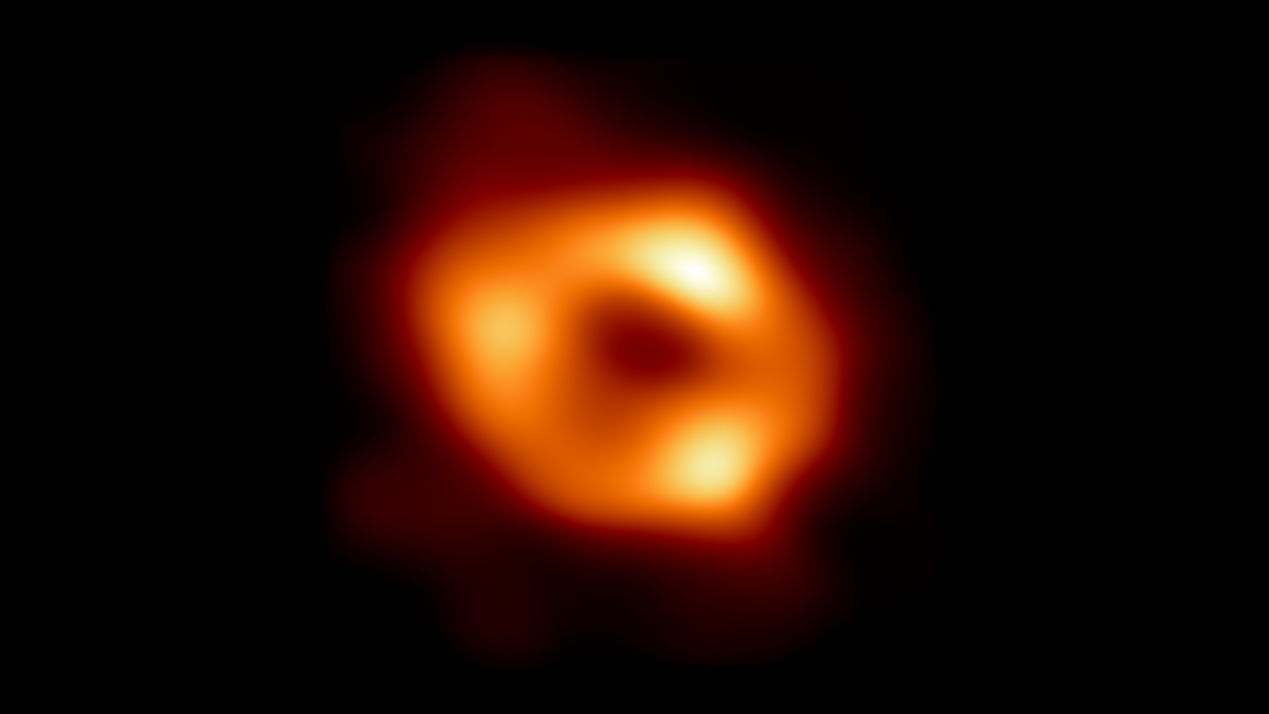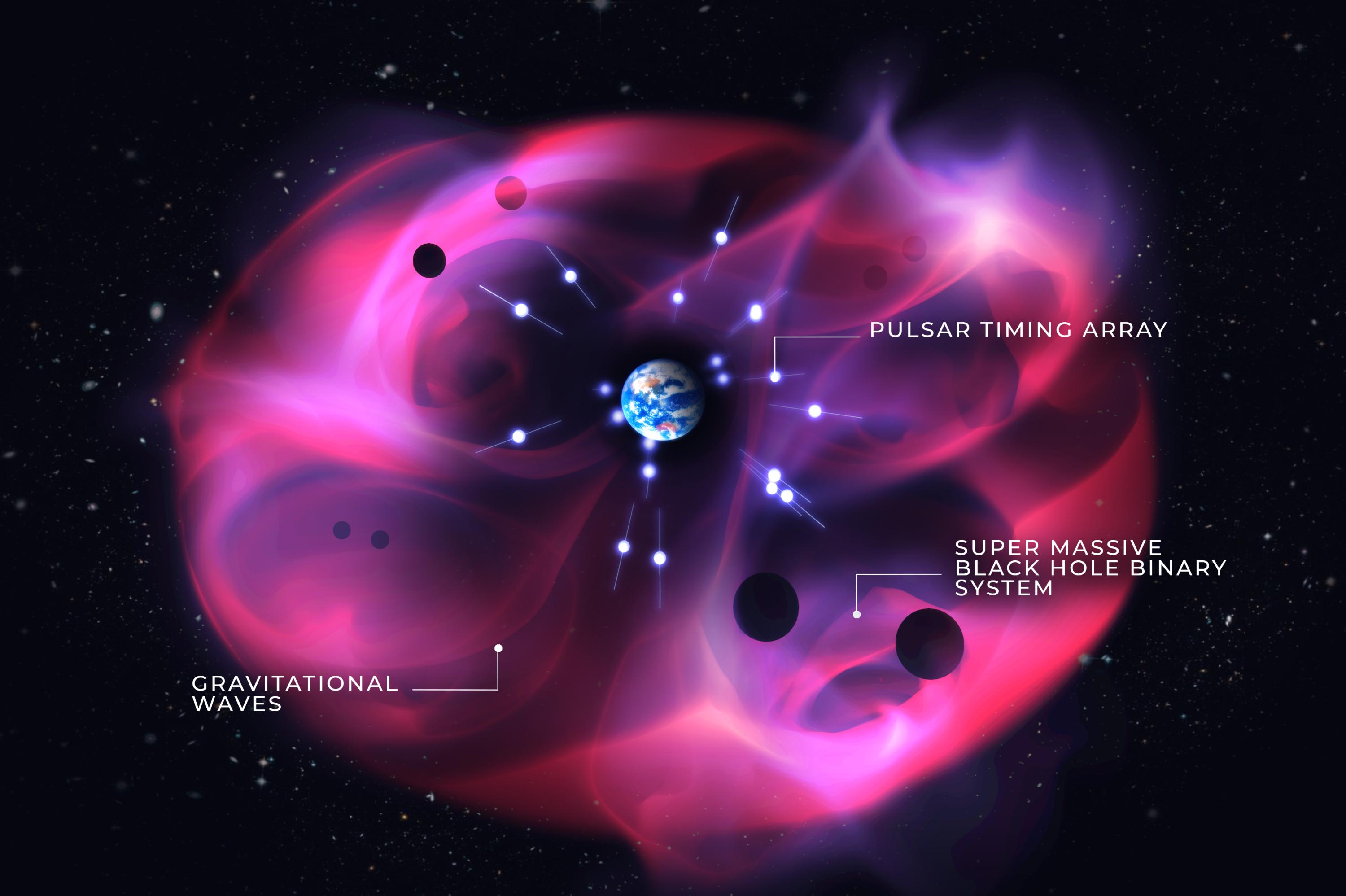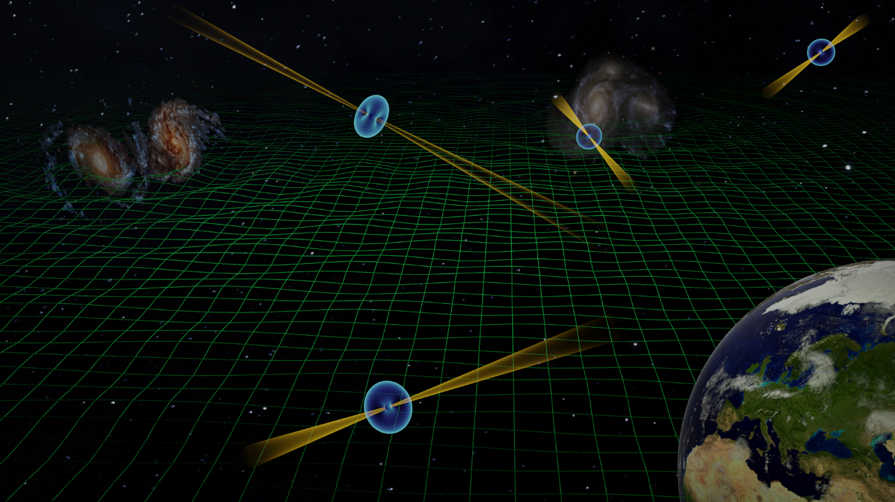 A team of astronomers, led by Professor Linhua Jiang at the Kavli Institute for Astronomy and Astrophysics and School of Physics at Peking University, has revealed that distant quasars or galactic nuclei with actively growing supermassive black holes made a negligible contribution of ionizing photons to cosmic reionization 13 billion years ago. This finding settles a long-standing issue about the quasar contribution to cosmic reionization, and suggests that galaxies are the major energy sources. The result was recently published as an article in Nature Astronomy on June 16, 2022. A team of astronomers, led by Professor Linhua Jiang at the Kavli Institute for Astronomy and Astrophysics and School of Physics at Peking University, has revealed that distant quasars or galactic nuclei with actively growing supermassive black holes made a negligible contribution of ionizing photons to cosmic reionization 13 billion years ago. This finding settles a long-standing issue about the quasar contribution to cosmic reionization, and suggests that galaxies are the major energy sources. The result was recently published as an article in Nature Astronomy on June 16, 2022.
|
 Astronomers have unveiled the first image of the supermassive black hole at the centre of our own Milky Way galaxy. This result provides overwhelming evidence that the object is indeed a black hole and yields valuable clues about the workings of such giants, which are thought to reside at the centre of most galaxies. The image was produced by a global research team called the Event Horizon Telescope (EHT) Collaboration, using observations from a worldwide network of radio telescopes. This effort involved three scientists affiliated with Peking University, including the Director and University Chair Professor Luis C. Ho and Assistant Professor Lijing Shao from the Kavli Institute for Astronomy and Astrophysics, and Assistant Professor He Sun from the College of Future Technology. Astronomers have unveiled the first image of the supermassive black hole at the centre of our own Milky Way galaxy. This result provides overwhelming evidence that the object is indeed a black hole and yields valuable clues about the workings of such giants, which are thought to reside at the centre of most galaxies. The image was produced by a global research team called the Event Horizon Telescope (EHT) Collaboration, using observations from a worldwide network of radio telescopes. This effort involved three scientists affiliated with Peking University, including the Director and University Chair Professor Luis C. Ho and Assistant Professor Lijing Shao from the Kavli Institute for Astronomy and Astrophysics, and Assistant Professor He Sun from the College of Future Technology.
|
 The International Pulsar Timing Array (IPTA), a team of astronomers and astrophysics from several collaborations from around the world, has recently announced the results of a comprehensive search for low-frequency gravitational waves (GWs) in their most recent official data release, known as Data Release 2 (DR2). The International Pulsar Timing Array (IPTA), a team of astronomers and astrophysics from several collaborations from around the world, has recently announced the results of a comprehensive search for low-frequency gravitational waves (GWs) in their most recent official data release, known as Data Release 2 (DR2).
|
 EPTA is a scientific collaboration bringing together teams of astronomers around the largest European radio telescopes, as well as groups specialized in data analysis and modelling of gravitational wave (GW) signals. It has published a detailed analysis of a candidate signal for the since-long sought gravitational wave background (GWB) due to in-spiraling supermassive black-hole binaries. Although a detection cannot be claimed yet, this represents another significant step in the effort to finally unveil GWs at very low frequencies, of order one billionth of a Hertz. In fact, the candidate signal has emerged from an unprecedented detailed analysis and using two independent methodologies. Moreover, the signal shares strong similarities with those found from the analyses of other teams. The results were made possible thanks to the data collected over 24 years with five large-aperture radio telescopes in Europe. EPTA is a scientific collaboration bringing together teams of astronomers around the largest European radio telescopes, as well as groups specialized in data analysis and modelling of gravitational wave (GW) signals. It has published a detailed analysis of a candidate signal for the since-long sought gravitational wave background (GWB) due to in-spiraling supermassive black-hole binaries. Although a detection cannot be claimed yet, this represents another significant step in the effort to finally unveil GWs at very low frequencies, of order one billionth of a Hertz. In fact, the candidate signal has emerged from an unprecedented detailed analysis and using two independent methodologies. Moreover, the signal shares strong similarities with those found from the analyses of other teams. The results were made possible thanks to the data collected over 24 years with five large-aperture radio telescopes in Europe.
|
 Imagine that you could go back in time and ask Albert Einstein if people could directly detect gravitational waves, the extraordinarily faint ‘ripples’ in space-time, it must be hard for him to admit that people could make it come true about 100 years after his prediction. However, if you ask Mr. Yacheng Kang and Ms. Chang Liu right now, an undergraduate and a PhD student respectively in Prof. Lijing Shao’s group, the prospects for detecting exoplanets with gravitational-wave observations, they will have a slightly more positive attitude toward it and show more details about that. Imagine that you could go back in time and ask Albert Einstein if people could directly detect gravitational waves, the extraordinarily faint ‘ripples’ in space-time, it must be hard for him to admit that people could make it come true about 100 years after his prediction. However, if you ask Mr. Yacheng Kang and Ms. Chang Liu right now, an undergraduate and a PhD student respectively in Prof. Lijing Shao’s group, the prospects for detecting exoplanets with gravitational-wave observations, they will have a slightly more positive attitude toward it and show more details about that.
|
 Clusters of galaxies formed from the largest cosmological structures; they are the destination of galaxies traveling along the cosmic web, and serve as the best testbed for environmental effects that accelerate galaxy evolution. The Hydra cluster is the largest and most mature cluster of galaxies within 200 million light years. In a recent paper led by KIAA professor Jing Wang, the powerful new radio telescope ASKAP was used to map neutral hydrogen (HI) in the Hydra Cluster, revealing how cluster dynamics drives the evolution of infalling satellite galaxies. These discoveries are based on the widest survey of Hydra to date in HI, part of the WALLABY pilot survey with ASKAP. Clusters of galaxies formed from the largest cosmological structures; they are the destination of galaxies traveling along the cosmic web, and serve as the best testbed for environmental effects that accelerate galaxy evolution. The Hydra cluster is the largest and most mature cluster of galaxies within 200 million light years. In a recent paper led by KIAA professor Jing Wang, the powerful new radio telescope ASKAP was used to map neutral hydrogen (HI) in the Hydra Cluster, revealing how cluster dynamics drives the evolution of infalling satellite galaxies. These discoveries are based on the widest survey of Hydra to date in HI, part of the WALLABY pilot survey with ASKAP.
|
 A team of astronomers, led by Professor Linhua Jiang at the Kavli Institute for Astronomy and Astrophysics and School of Physics at Peking University, has revealed that distant quasars or galactic nuclei with actively growing supermassive black holes made a negligible contribution of ionizing photons to cosmic reionization 13 billion years ago. This finding settles a long-standing issue about the quasar contribution to cosmic reionization, and suggests that galaxies are the major energy sources. The result was recently published as an article in Nature Astronomy on June 16, 2022.
A team of astronomers, led by Professor Linhua Jiang at the Kavli Institute for Astronomy and Astrophysics and School of Physics at Peking University, has revealed that distant quasars or galactic nuclei with actively growing supermassive black holes made a negligible contribution of ionizing photons to cosmic reionization 13 billion years ago. This finding settles a long-standing issue about the quasar contribution to cosmic reionization, and suggests that galaxies are the major energy sources. The result was recently published as an article in Nature Astronomy on June 16, 2022.
 Astronomers have unveiled the first image of the supermassive black hole at the centre of our own Milky Way galaxy. This result provides overwhelming evidence that the object is indeed a black hole and yields valuable clues about the workings of such giants, which are thought to reside at the centre of most galaxies. The image was produced by a global research team called the Event Horizon Telescope (EHT) Collaboration, using observations from a worldwide network of radio telescopes. This effort involved three scientists affiliated with Peking University, including the Director and University Chair Professor Luis C. Ho and Assistant Professor Lijing Shao from the Kavli Institute for Astronomy and Astrophysics, and Assistant Professor He Sun from the College of Future Technology.
Astronomers have unveiled the first image of the supermassive black hole at the centre of our own Milky Way galaxy. This result provides overwhelming evidence that the object is indeed a black hole and yields valuable clues about the workings of such giants, which are thought to reside at the centre of most galaxies. The image was produced by a global research team called the Event Horizon Telescope (EHT) Collaboration, using observations from a worldwide network of radio telescopes. This effort involved three scientists affiliated with Peking University, including the Director and University Chair Professor Luis C. Ho and Assistant Professor Lijing Shao from the Kavli Institute for Astronomy and Astrophysics, and Assistant Professor He Sun from the College of Future Technology.
 The International Pulsar Timing Array (IPTA), a team of astronomers and astrophysics from several collaborations from around the world, has recently announced the results of a comprehensive search for low-frequency gravitational waves (GWs) in their most recent official data release, known as Data Release 2 (DR2).
The International Pulsar Timing Array (IPTA), a team of astronomers and astrophysics from several collaborations from around the world, has recently announced the results of a comprehensive search for low-frequency gravitational waves (GWs) in their most recent official data release, known as Data Release 2 (DR2).
 EPTA is a scientific collaboration bringing together teams of astronomers around the largest European radio telescopes, as well as groups specialized in data analysis and modelling of gravitational wave (GW) signals. It has published a detailed analysis of a candidate signal for the since-long sought gravitational wave background (GWB) due to in-spiraling supermassive black-hole binaries. Although a detection cannot be claimed yet, this represents another significant step in the effort to finally unveil GWs at very low frequencies, of order one billionth of a Hertz. In fact, the candidate signal has emerged from an unprecedented detailed analysis and using two independent methodologies. Moreover, the signal shares strong similarities with those found from the analyses of other teams. The results were made possible thanks to the data collected over 24 years with five large-aperture radio telescopes in Europe.
EPTA is a scientific collaboration bringing together teams of astronomers around the largest European radio telescopes, as well as groups specialized in data analysis and modelling of gravitational wave (GW) signals. It has published a detailed analysis of a candidate signal for the since-long sought gravitational wave background (GWB) due to in-spiraling supermassive black-hole binaries. Although a detection cannot be claimed yet, this represents another significant step in the effort to finally unveil GWs at very low frequencies, of order one billionth of a Hertz. In fact, the candidate signal has emerged from an unprecedented detailed analysis and using two independent methodologies. Moreover, the signal shares strong similarities with those found from the analyses of other teams. The results were made possible thanks to the data collected over 24 years with five large-aperture radio telescopes in Europe.
 Imagine that you could go back in time and ask Albert Einstein if people could directly detect gravitational waves, the extraordinarily faint ‘ripples’ in space-time, it must be hard for him to admit that people could make it come true about 100 years after his prediction. However, if you ask Mr. Yacheng Kang and Ms. Chang Liu right now, an undergraduate and a PhD student respectively in Prof. Lijing Shao’s group, the prospects for detecting exoplanets with gravitational-wave observations, they will have a slightly more positive attitude toward it and show more details about that.
Imagine that you could go back in time and ask Albert Einstein if people could directly detect gravitational waves, the extraordinarily faint ‘ripples’ in space-time, it must be hard for him to admit that people could make it come true about 100 years after his prediction. However, if you ask Mr. Yacheng Kang and Ms. Chang Liu right now, an undergraduate and a PhD student respectively in Prof. Lijing Shao’s group, the prospects for detecting exoplanets with gravitational-wave observations, they will have a slightly more positive attitude toward it and show more details about that.
 Clusters of galaxies formed from the largest cosmological structures; they are the destination of galaxies traveling along the cosmic web, and serve as the best testbed for environmental effects that accelerate galaxy evolution. The Hydra cluster is the largest and most mature cluster of galaxies within 200 million light years. In a recent paper led by KIAA professor Jing Wang, the powerful new radio telescope ASKAP was used to map neutral hydrogen (HI) in the Hydra Cluster, revealing how cluster dynamics drives the evolution of infalling satellite galaxies. These discoveries are based on the widest survey of Hydra to date in HI, part of the WALLABY pilot survey with ASKAP.
Clusters of galaxies formed from the largest cosmological structures; they are the destination of galaxies traveling along the cosmic web, and serve as the best testbed for environmental effects that accelerate galaxy evolution. The Hydra cluster is the largest and most mature cluster of galaxies within 200 million light years. In a recent paper led by KIAA professor Jing Wang, the powerful new radio telescope ASKAP was used to map neutral hydrogen (HI) in the Hydra Cluster, revealing how cluster dynamics drives the evolution of infalling satellite galaxies. These discoveries are based on the widest survey of Hydra to date in HI, part of the WALLABY pilot survey with ASKAP.
